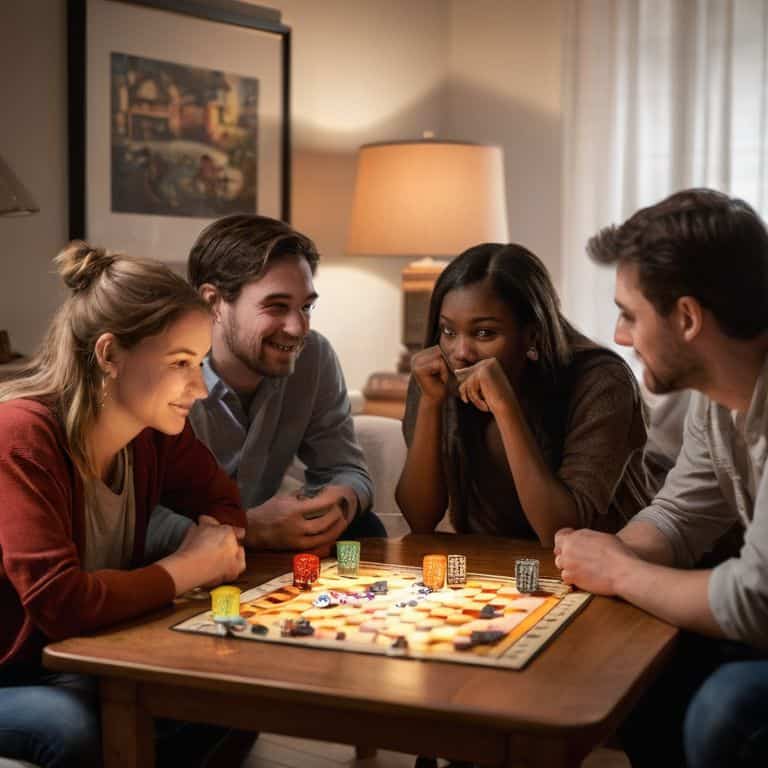I still remember the board game nights I host, where knowing when to agree to disagree can be the difference between a fun evening and a heated argument. One particular night stands out, when a debate over a game rule escalated into a full-blown discussion about the meaning of life. It was then that I realized, sometimes you just have to let go and focus on the relationship, not the argument. This experience taught me the value of healthy communication and the importance of navigating conflicts with empathy.
As a relationship coach, I’ve seen how knowing when to agree to disagree can make or break relationships. In this article, I promise to provide you with practical tools and real-life examples to help you navigate those tricky conversations. I won’t give you generic advice or tell you to “just listen more” – instead, I’ll share actionable scripts and exercises that have worked for my clients and me. My goal is to help you build stronger, more peaceful relationships by focusing on the skills that really matter, not just the theory. So, let’s dive in and explore the art of agreeing to disagree together.
Table of Contents
Navigating Disagreements

When navigating disagreements, it’s essential to focus on effective communication in relationships. This means actively listening to the other person, trying to understand their perspective, and expressing your own thoughts and feelings clearly. I’ve seen this play out in my board game nights, where a simple miscommunication can lead to a heated argument. By _practicing empathy_ and asking open-ended questions, we can often find common ground and resolve the issue at hand.
In my experience as a relationship coach, I’ve found that _managing disagreements at work_ can be particularly challenging. This is because we often bring our personal biases and emotions into the conversation, making it difficult to separate the issue from our own identities. To overcome this, it’s crucial to set clear boundaries and focus on the specific problem, rather than making personal attacks. By doing so, we can create a safe and respectful space for discussion, even in the face of disagreement.
By learning to navigate disagreements in a healthy and constructive way, we can actually _strengthen our relationships_ and build trust with others. This requires a willingness to compromise and find common ground, rather than trying to “win” the argument. As I always say to my clients, “it’s not about being right, it’s about being heard.” By _practicing active listening_ and seeking to understand the other person’s perspective, we can create a more harmonious and respectful dynamic, even in the face of disagreement.
Effective Communication in Relationships
To build stronger relationships, we need to focus on effective listening, which involves truly hearing and understanding the other person’s perspective. This means setting aside our own biases and emotions, and creating a safe space for open dialogue. By doing so, we can avoid misunderstandings and miscommunications that often escalate into full-blown conflicts.
In my experience as a relationship coach, I’ve seen that active empathy is key to resolving disagreements and strengthening bonds. When we make an effort to see things from our partner’s point of view, we can find common ground and work towards a mutually beneficial solution. This approach helps to diffuse tension and creates a more positive, respectful atmosphere in our interactions.
Signs of Unhealthy Conflict to Watch
When disagreements arise, it’s essential to recognize the signs of unhealthy conflict. These can include raised voices, personal attacks, and a general sense of tension. If you find yourself or your partner consistently exhibiting these behaviors, it may be time to take a step back and reassess the situation.
In such cases, active listening becomes crucial. This means making a conscious effort to hear and understand the other person’s perspective, rather than simply waiting for your turn to speak. By doing so, you can begin to diffuse tension and create a more constructive dialogue.
Knowing When to Agree

When we find ourselves in the midst of a heated discussion, it can be challenging to recognize the moment when it’s time to let go of the need to be right. However, this is often a crucial step in maintaining healthy relationships. By acknowledging that we can’t always see eye-to-eye, we open the door to effective communication in relationships, which is essential for resolving conflicts and deepening our connections with others.
In my experience as a relationship coach, I’ve seen how signs of unhealthy conflict can escalate into full-blown disputes. But when we learn to identify these signs and take a step back, we can create space for more constructive conversations. This is where active listening comes in – by truly hearing each other out, we can begin to understand the underlying needs and concerns that are driving the disagreement.
By embracing the benefits of compromise in relationships, we can transform potential conflicts into opportunities for growth and understanding. This doesn’t mean sacrificing our own needs or values, but rather finding creative solutions that work for everyone involved. As we practice managing disagreements in a more mindful and compassionate way, we can build stronger, more resilient relationships that can weather any storm.
Benefits of Compromise in Relationships
When we learn to compromise, we open ourselves up to a world of deeper understanding and empathy. By finding common ground and meeting in the middle, we can strengthen our relationships and build trust with others. This, in turn, allows us to navigate conflicts with more ease and grace.
Embracing compromise can also lead to healthier communication patterns, where both parties feel heard and valued. As we practice active listening and work together to find mutually beneficial solutions, we create a safe and supportive environment for our relationships to thrive.
Strategies for Active Listening in Disagreements
When engaging in disagreements, it’s essential to practice active listening. This means fully concentrating on what the other person is saying, rather than just waiting for your turn to respond. By doing so, you can pick up on subtle cues and underlying concerns that may be driving the disagreement.
To effectively listen, try using open-ended questions to encourage the other person to share their thoughts and feelings. This can help to clarify their perspective and prevent misunderstandings, ultimately leading to a more productive and respectful conversation.
Embracing the Art of Agreement: 5 Tips to Know When to Disagree
- Recognize when the conversation is no longer about finding a solution, but about ‘winning’ the argument – that’s when it’s time to agree to disagree
- Practice self-awareness to understand your own emotional triggers and limitations, allowing you to step back when necessary and prioritize the relationship over being ‘right’
- Identify and acknowledge the underlying needs and fears driving the disagreement, and address those directly to diffuse tension and create a more constructive dialogue
- Learn to distinguish between non-negotiables and areas where compromise is possible, and be willing to flex and find common ground when it doesn’t compromise your core values
- Develop a growth mindset and see disagreements as opportunities for growth, learning, and deeper understanding of each other’s perspectives, rather than threats to your ego or relationships
Key Takeaways for Healthy Disagreements
Learning to recognize when a conversation is no longer productive and knowing when to agree to disagree can be a powerful tool in reducing stress and improving relationships
Effective communication and active listening are crucial in navigating disagreements, and strategies such as acknowledging each other’s perspectives and focusing on the issue rather than the person can help to resolve conflicts in a healthy manner
By prioritizing understanding and respect over being ‘right’, and being willing to compromise and find common ground, we can build stronger, more peaceful relationships and create a more supportive and inclusive environment for open and honest communication
Embracing the Freedom to Disagree
Knowing when to agree to disagree isn’t about giving up or giving in, it’s about recognizing that our differences are what make our relationships richer, and that sometimes, the most loving thing we can do is let go of the need to be right.
Mia Campbell
Embracing the Art of Agreeing to Disagree

As we navigate the complexities of relationships and disagreements, it’s essential to remember that effective communication is key to resolving conflicts in a healthy manner. We’ve explored the importance of recognizing signs of unhealthy conflict, the benefits of compromise, and strategies for active listening. By being aware of these factors, we can better understand when to engage in discussions and when to agree to disagree, allowing us to maintain respect and understanding for each other’s perspectives. This mindset shift can significantly reduce stress and improve the quality of our daily interactions.
As we move forward, let’s embrace the idea that relationships are a journey, not a destination. By acknowledging that we won’t always see eye-to-eye and being open to growth, we can transform our interactions into opportunities for mutual understanding and respect. So, the next time you find yourself in a disagreement, take a deep breath, listen actively, and remember that it’s okay to agree to disagree – for it’s in these moments that we can truly build stronger, more peaceful relationships.
Frequently Asked Questions
How can I distinguish between a disagreement that can be resolved through communication and one that requires agreeing to disagree?
For me, it comes down to noticing when we’re debating facts versus values. If it’s a fact-based disagreement, communication can often resolve it. But when values are at play, it’s usually a sign that we’re at an impasse, and agreeing to disagree can be a beautiful way to preserve the relationship.
What are some common pitfalls to avoid when trying to agree to disagree with someone, especially in a romantic relationship or close friendship?
One major pitfall is taking it personally and getting defensive, which can escalate the situation. Instead, focus on the issue at hand and try to understand the other person’s perspective, using phrases like “I hear you” or “That makes sense to me” to show you’re listening and acknowledge their feelings.
Can agreeing to disagree be a sign of weakness or lack of conviction, or is it actually a strength in relationships and communication?
I believe agreeing to disagree is actually a sign of strength, not weakness. It takes courage to acknowledge you’ve reached an impasse and choose to prioritize the relationship over being “right.” By doing so, you’re showing that you value the other person’s perspective and are willing to compromise, which can ultimately bring you closer together.
